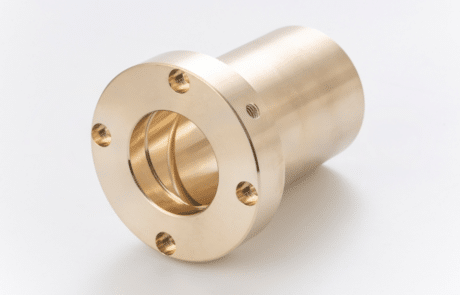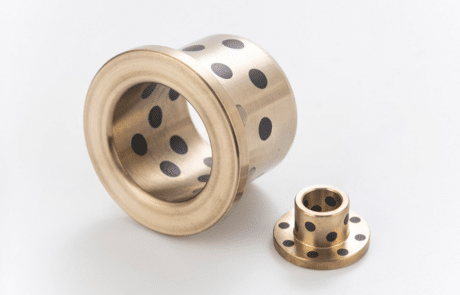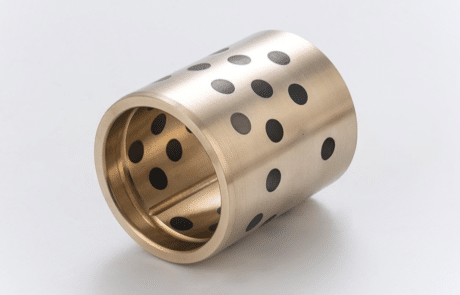Understanding Copper Casting Alloy: DIN 17656-1983 Grades and Chemical Compositions
Bearings and Bushings for the Future: Precision and Customization: Our company, in bearing engineering with decades of experience, designs and develops high-precision self-lubricating bronze bearings & plain bushes. We offer a wide array of sliding bearings tailored to meet specific needs. Renowned for our expertise in custom bronze bushing and slide plate solutions, we provide an expansive selection of bushing metal alloys. Contact us today to benefit from unparalleled services at competitive prices.
Understanding Copper Casting Alloy: DIN 17656-1983 Grades and Chemical Compositions
Explore Other Alloys, Suggested Searches: Copper Brass Bronze Copper Nickel
Bearing Bushing, Search Our Material Alloy

COPPER CASTING ALLOYS
Solid Lubricant Embedded Slide Bearing
Unlocking Performance: A Deep Dive into Copper Casting Alloys for Bushings & Bearings
In the intricate world of mechanical engineering and manufacturing, the performance and longevity of components often hinge on the smallest parts. Among these critical elements are bushings and bearings – the unsung heroes that reduce friction, support shafts, and manage wear between moving parts. While various materials can be used, copper casting alloys, particularly bronzes and brasses, stand out for their unique combination of properties.
This article goes beyond the surface, exploring why these alloys are favoured, contrasting key types, and delving into the specifics of solid brass bushings and the advanced capabilities of self-lubricating CNC bronze alloy bushings.
What are Copper Casting Alloys and Why Use Them?
Copper, on its own, is relatively soft and ductile. However, when alloyed (mixed) with other elements like zinc, tin, aluminum, silicon, nickel, or lead, its properties transform dramatically. These copper alloys gain:
-
Increased Strength and Hardness: Essential for load-bearing applications.
-
Enhanced Wear Resistance: Crucial for components subjected to friction.
-
Improved Corrosion Resistance: Vital for longevity in various environments.
-
Better Machinability: Allows for precise shaping and finishing.
-
Excellent Castability: Enables complex shapes to be formed efficiently.
The “casting” aspect refers to the manufacturing process where molten alloy is poured into a mold to create a near-net-shape part. Copper alloys often exhibit good fluidity and predictable shrinkage, making them ideal for casting processes used to produce blanks for bushings.
Spotlight on Bushings: Brass vs. Bronze
Bushings (also known as plain bearings or sleeve bearings) are essentially cylindrical sleeves designed to provide a low-friction surface for rotating or sliding shafts. When selecting a material, the choice often comes down to brass or bronze. While both are copper-based, their specific alloying elements give them distinct characteristics.
1. Solid Brass Bushings:
-
Composition: Primarily Copper (Cu) and Zinc (Zn). May contain small amounts of lead (Pb) for improved machinability.
-
Key Characteristics: Generally offers good machinability, moderate strength, fair corrosion resistance, and a relatively lower cost compared to many bronzes. They often have a brighter, yellowish appearance.
-
Common Alloys: C83600 (Leaded Red Brass), C84400 (Leaded Semi-Red Brass).
2. Bronze Bushings:
-
Composition: Traditionally Copper (Cu) and Tin (Sn). However, modern “bronzes” encompass a wider range, including Aluminum Bronzes (Cu-Al), Silicon Bronzes (Cu-Si), and Manganese Bronzes (technically high-strength brasses, but often grouped here functionally). Lead (Pb) is often added to bearing bronzes for lubricity and machinability.
-
Key Characteristics: Generally offer superior wear resistance, higher strength and hardness, and better corrosion resistance than standard brasses, particularly in harsh environments. They can handle higher loads and temperatures. Appearance varies from reddish-gold to brown depending on the specific alloy.
-
Common Alloys: C93200 (SAE 660 – Bearing Bronze), C95400 (Aluminum Bronze), C86300 (Manganese Bronze).
Brass vs. Bronze Bushings: A Comparative Overview
To make the differences clearer, let’s contrast them directly:
| Feature | Solid Brass Bushings (Typical) | Solid Bronze Bushings (Typical Bearing Grades) | Why it Matters for Bushings |
| Primary Alloying Element(s) | Zinc (Zn) | Tin (Sn), Aluminum (Al), Silicon (Si) | Determines fundamental material properties. |
| Strength | Moderate | High to Very High | Ability to withstand static and dynamic loads without deforming. |
| Hardness | Moderate | High | Resistance to indentation and scratching. |
| Wear Resistance | Fair to Good | Excellent | Crucial for longevity under friction; Bronze generally excels. |
| Corrosion Resistance | Good | Very Good to Excellent (esp. Aluminum Bronze) | Performance in humid, chemical, or marine environments. |
| Machinability | Good to Excellent (esp. leaded brass) | Good (often improved with lead) | Ease of manufacturing to precise tolerances (e.g., CNC). |
| Bearing Properties (Load/Speed) | Moderate Load, Moderate Speed | High Load, Moderate/High Speed | Suitability for demanding applications. |
| Thermal Conductivity | Good | Good | Ability to dissipate heat generated by friction. |
| Cost | Generally Lower | Generally Higher | Budget considerations vs. performance requirements. |
| Typical Uses | General purpose fittings, light-duty bearings, decorative applications | Heavy-duty bearings, gears, marine hardware, valve components | Matching the alloy to the application demands. |
Key Takeaway: While brass bushings are suitable for many general-purpose, moderate-load applications, bronze alloys are typically the superior choice for demanding bearing applications requiring high strength, exceptional wear resistance, and reliable performance under significant loads or harsh conditions.
The Advancement: Self-Lubricating Bronze Alloy Bushings
Traditional solid bronze bushings require external lubrication (grease or oil) to minimize friction and wear. However, this isn’t always practical or desirable due to:
-
Maintenance requirements (re-lubrication).
-
Potential for lubricant contamination (e.g., in food processing or clean environments).
-
Difficulty accessing the bushing for lubrication.
-
Operation in extreme temperatures where liquid lubricants fail.
This is where self-lubricating bronze bushings come into play. These innovative components provide their own lubrication, eliminating the need for external grease or oil. There are two primary types:
1. Sintered Bronze (Oil-Impregnated) Bushings:
-
How they work: Made using powder metallurgy. Fine bronze powder is pressed into shape and then heated (sintered) below its melting point. This creates a strong but porous structure (typically 15-30% porosity). This porous network is then impregnated with lubricating oil under vacuum. During operation, heat generated by friction draws the oil out of the pores to the bearing surface. When stopped, capillary action draws most of the oil back in.
-
Pros: Cost-effective for high volumes, quiet operation, good for moderate loads/speeds.
-
Cons: Limited load capacity compared to solid bronze, oil can deplete over time or dry out at high temperatures.
2. Solid Bronze Bushings with Solid Lubricant Inserts:
-
How they work: These start as solid bronze alloy bushings (often high-strength alloys like C93200 or C95400). Precisely machined pockets or grooves are created on the bearing surface. These pockets are then filled with solid lubricant plugs or inserts, typically graphite or PTFE (Polytetrafluoroethylene). As the shaft moves, it makes contact with both the bronze and the solid lubricant. A thin, low-friction film of the solid lubricant is transferred to the mating surfaces, providing continuous lubrication.
-
Pros:
-
High Load Capacity: Retains the strength of the solid bronze base material.
-
Maintenance-Free: True “lubricated for life” performance in many applications.
-
Wide Temperature Range: Performance limited by the solid lubricant and base metal, often exceeding oil capabilities.
-
Clean Operation: No oil or grease leakage.
-
Excellent for Slow Speed, High Load, Oscillating Motion: Where establishing a hydrodynamic oil film is difficult.
-
Suitable for Contaminated Environments: No liquid lubricant to attract dirt.
-
-
Cons: Generally higher initial cost than sintered or plain bronze bushings.
This second type directly addresses the “solid… self-lubricating… bronze alloy bushing” keyword phrase. They combine the robustness of solid bronze with the maintenance-free benefits of embedded solid lubrication.
The CNC Connection: Precision Matters
The term “CNC bronze alloy bushing” highlights the manufacturing process used to achieve the high precision required in modern machinery. Computer Numerical Control (CNC) machining allows for:
-
Tight Tolerances: Ensuring perfect fit and alignment, critical for bearing performance and minimizing vibration.
-
Complex Geometries: Creating features like lubrication grooves, oil holes, or the precise pockets for solid lubricant inserts.
-
Superior Surface Finish: Reducing initial friction and wear, promoting smooth operation.
-
Repeatability: Ensuring consistent quality across large production runs.
For high-performance applications, especially those involving self-lubricating features, CNC machining is often essential to guarantee the bushing meets exact specifications for clearance, concentricity, and the placement/fit of lubricant plugs.
Choosing the Right Bushing: Key Considerations
Selecting the optimal copper alloy bushing involves balancing several factors:
-
Load: Magnitude and type (static, dynamic, shock). Higher loads favour stronger bronzes.
-
Speed: Surface speed of the shaft. Affects heat generation and lubrication requirements.
-
Motion Type: Continuous rotation, oscillation, linear motion. Influences lubrication film formation.
-
Operating Temperature: Affects material strength and lubricant viability.
-
Environment: Presence of moisture, chemicals, abrasives, or contaminants. Dictates corrosion resistance needs and suitability of lubrication type.
-
Lubrication: Is external lubrication possible/desirable? If not, self-lubricating options are necessary.
-
Required Life & Maintenance: How long must it last? Is periodic maintenance acceptable?
-
Cost: Balancing initial cost against performance and lifetime value.
Conclusion
Copper casting alloys, particularly brass and bronze, offer a powerful combination of strength, wear resistance, machinability, and corrosion resistance, making them premier materials for bushings and bearings. While solid brass provides a cost-effective solution for moderate applications, bronze alloys excel in demanding scenarios requiring higher loads and superior wear characteristics.
The evolution towards self-lubricating bronze bushings, especially those featuring solid lubricant inserts (like graphite or PTFE) within a solid bronze CNC-machined body, represents a significant advancement. These components deliver maintenance-free operation, high load capacity, and reliable performance in challenging environments, making them indispensable in applications ranging from heavy industrial machinery to precision CNC equipment. Understanding the nuances between these alloys and types allows engineers and designers to select the perfect bushing, ensuring optimal performance, longevity, and efficiency for their specific needs.
Providing Brass, Bronze, and Specialty Copper Alloys, Copper Alloy Machining Services

Solutions For Every Industry
Searching for Dependable Bushing Solutions? viiplus Has What You Need.

Design Guides, Materials
Bushing design, Comprehensive design manuals covering a range of self-lubricating materials used in all of viiplus’s manufacturing processes.

Technical Guides
Manufacturing On Demand, Technical Guides For Machining Design. Discover the latest in metal alloys, materials, and design tips for manufacturing custom machined and self-lubricating bearing parts.

Get Instant Quote
To receive your instant quote, simply upload your drawing file and choose your production process & bushing material.

Prototyping, Place Order
After you place your order, we will start the production process. You will receive updates when your order has completed production and is ready to be dispatched.

Receive Your custom Parts
We provide precision-inspected high-quality parts, packing lists and documents, and delivery tracking.





